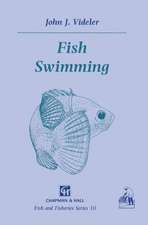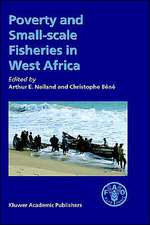The Ecology and Etiology of Newly Emerging Marine Diseases: Developments in Hydrobiology, cartea 159
Editat de James W. Porteren Limba Engleză Paperback – 28 oct 2010
| Toate formatele și edițiile | Preț | Express |
|---|---|---|
| Paperback (1) | 792.00 lei 38-45 zile | |
| SPRINGER NETHERLANDS – 28 oct 2010 | 792.00 lei 38-45 zile | |
| Hardback (1) | 803.80 lei 38-45 zile | |
| SPRINGER NETHERLANDS – 31 dec 2001 | 803.80 lei 38-45 zile |
Din seria Developments in Hydrobiology
- 18%
 Preț: 1229.10 lei
Preț: 1229.10 lei - 18%
 Preț: 959.98 lei
Preț: 959.98 lei - 18%
 Preț: 963.91 lei
Preț: 963.91 lei - 15%
 Preț: 648.24 lei
Preț: 648.24 lei - 15%
 Preț: 637.89 lei
Preț: 637.89 lei -
 Preț: 378.23 lei
Preț: 378.23 lei - 15%
 Preț: 644.95 lei
Preț: 644.95 lei - 18%
 Preț: 952.09 lei
Preț: 952.09 lei - 20%
 Preț: 558.87 lei
Preț: 558.87 lei - 18%
 Preț: 1833.65 lei
Preț: 1833.65 lei -
 Preț: 393.59 lei
Preț: 393.59 lei -
 Preț: 406.54 lei
Preț: 406.54 lei - 18%
 Preț: 1226.73 lei
Preț: 1226.73 lei - 18%
 Preț: 956.99 lei
Preț: 956.99 lei -
 Preț: 388.87 lei
Preț: 388.87 lei - 24%
 Preț: 1060.51 lei
Preț: 1060.51 lei - 18%
 Preț: 1229.28 lei
Preț: 1229.28 lei - 20%
 Preț: 569.30 lei
Preț: 569.30 lei -
 Preț: 368.79 lei
Preț: 368.79 lei - 24%
 Preț: 817.46 lei
Preț: 817.46 lei - 18%
 Preț: 958.25 lei
Preț: 958.25 lei - 18%
 Preț: 953.03 lei
Preț: 953.03 lei -
 Preț: 384.75 lei
Preț: 384.75 lei - 24%
 Preț: 1582.91 lei
Preț: 1582.91 lei - 24%
 Preț: 1051.68 lei
Preț: 1051.68 lei - 18%
 Preț: 943.57 lei
Preț: 943.57 lei - 18%
 Preț: 1235.76 lei
Preț: 1235.76 lei - 24%
 Preț: 800.02 lei
Preț: 800.02 lei - 24%
 Preț: 803.55 lei
Preț: 803.55 lei - 18%
 Preț: 948.29 lei
Preț: 948.29 lei
Preț: 792.00 lei
Preț vechi: 1042.11 lei
-24% Nou
Puncte Express: 1188
Preț estimativ în valută:
151.57€ • 158.04$ • 125.97£
151.57€ • 158.04$ • 125.97£
Carte tipărită la comandă
Livrare economică 17-24 martie
Preluare comenzi: 021 569.72.76
Specificații
ISBN-13: 9789048159307
ISBN-10: 904815930X
Pagini: 248
Ilustrații: XVI, 228 p. 84 illus., 8 illus. in color.
Dimensiuni: 210 x 279 x 13 mm
Greutate: 0.54 kg
Ediția:2001
Editura: SPRINGER NETHERLANDS
Colecția Springer
Seria Developments in Hydrobiology
Locul publicării:Dordrecht, Netherlands
ISBN-10: 904815930X
Pagini: 248
Ilustrații: XVI, 228 p. 84 illus., 8 illus. in color.
Dimensiuni: 210 x 279 x 13 mm
Greutate: 0.54 kg
Ediția:2001
Editura: SPRINGER NETHERLANDS
Colecția Springer
Seria Developments in Hydrobiology
Locul publicării:Dordrecht, Netherlands
Public țintă
ResearchCuprins
Patterns of spread of coral disease in the Florida Keys.- White-band disease and the changing face of Caribbean coral reefs.- Quantitative assessment of coral diseases in the Florida Keys: strategy and methodology.- Yellow band and dark spot syndromes in Caribbean corals: distribution, rate of spread, cytology, and effects on abundance and division rate of zooxanthellae.- Stony coral diseases observed in southwestern Caribbean reefs.- Integrating microbiological, microsensor, molecular, and physiologic techniques in the study of coral disease pathogenesis.- Laboratory models for the study of coral pathologies.- Coral bleaching and disease: contributors to 1998 mass mortality in Briareum asbestinum (Octocorallia, Gorgonacea).- Characterization of Aspergillus sydowii (Thom et Church), a fungal pathogen of Caribbean sea fan corals.- Disease in Zoanthids: dynamics in space and time.- Microbial disease causation in marine invertebrates: problems, practices, and future prospects.- Marine ecosystems and cholera.- Seasonal and interannual cycles of endemic cholera in Bengal 1891-1940 in relation to climate and geography.- Vibrio cholerae in recreational beach waters and tributaries of Southern California.- Occurrence and distribution of the human pathogen Vibrio vulnificus in a subtropical Gulf of Mexico estuary.- Enteroviruses detected by reverse transcriptase polymerase chain reaction from the coastal waters of Santa Monica Bay, California: low correlation to bacterial indicator levels.- Demographic, landscape, and meteorological factors controlling the microbial pollution of coastal waters.- Modeling studies of the effect of climate variability on MSX disease in eastern oyster (Crassostrea virginica) populations.- How are climate and marine biological outbreaks functionallylinked?.- Mycoses in red snapper (Lutjanus campechanus) caused by two deuteromycete fungi (Penicillium corylophilum and Cladosporium sphaerospermum).

















